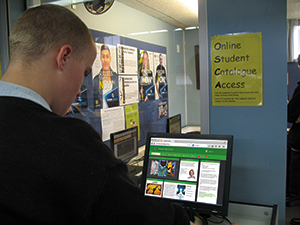



Access-It library and information management system is the most widely used software of its type in our schools, as well as being used in more than 30 other countries around the world. School News spoke to the librarians at two New Zealand schools to find out why they like Access-It so much and how it offers solutions to their teachers and students.
| A student using Access-it at the Hornby High School library. |
Hornby High School, Christchurch
Librarian Lynda Seaton says Access-It was one of the things she had been wanting for a considerable time and when the decision was made to get Access-It, she was “ecstatic”.
“We had a system, but it wasn’t providing enough. We needed modern teaching and learning features that would encourage students with different learning styles to engage with the library in their environments like classrooms and at home.”
Hornby High underwent a significant change at the beginning of 2014, when nearby Branston Intermediate closed and many of the students chose to go to Hornby High School.
“There was a refocus of the way forward for the school as we move to MLP and MLE.” In terms of support, she says Access-It offers one of the best training systems she has come across.
“There is a wonderful series of training videos. Each one is beautifully narrated, and not too long. You are supported every step of the way and if you are not sure about something you can go back and play the video again. It’s stress-free. All aspects of the process, from data migration to technology integrations with the school’s IT infrastructure are dealt with professionally and collaboratively.”
Access-It also has a free mobile app and works well with the variety of devices students utilise, including tablets, she says.
“Then there are the time-saving features, like automatic cataloguing, quick scan for weeding and data replace for global changes. Access-It is both customised to what you need, and is customisable. Whatever bright idea I might have, can be realised with the system – that’s the part I love.
“On the promotional side, it has a graphic interface so students can make a visual search for a topic. This is especially helpful for students with dyslexia, or ESOL students.”
Ms Seaton says she has become even more pleased with Access-It, the further she has got into it. “What I especially like is its efficiency – everything is in a logical sequence – I love that.”
Raroa Normal Intermediate, Wellington
| A Raroa Normal Intermediate student issuing his own book with Access-it. |
This intermediate school has had Access-It for about five years, librarian Clare Forrest says.
“Our old system wasn’t internet-based, and when we were wanting to get a new system we heard a lot about Access-It, and that people liked it. I saw it demonstrated at an Access-It Road Show and I liked the look of it.
“We can do so much with it, and what I like is that it’s as user-friendly for the students as it is for the librarians. It’s called Access-It for a reason, and that’s because it’s accessible everywhere, in the daytime at school and at home in the evening, and that’s important.
“The Search functions are very good, and they are not just boring blank pages, they are visually attractive. And you can add videos and other types of digital resources.
“In terms of being online, having a library presence online allows you to showcase your library. What we really like about it is that when students look up a book it has the facilities to show the video of a book trailer and a link to the author’s website. Kids are really digital now and they love the visual side of things.”
Another function Ms Forrest finds especially useful is One Search.
“It’s interactive and at this intermediate stage, for kids to learn how to research topics, we can add things to the search. They can type in the subject they want to research and find what books the library has on it. The library can also add databases so tabs come up and show them other places to go.
“One Search is so important for kids. It’s really good to make it easy for them and it helps the teachers because they want them to use a variety of resources, including books.”
The children are all learning how to issue their own books with Access-It, Ms Forrest says.
“The Access-It system then emails them when their books are due back, it’s all automatic.
“The service has always been good,” she says, and they are always updating the system. The Road Show is good, too. They cater for two groups – beginners and those who are familiar with the system, and they always listen to people.”
Raroa Intermediate students come from about seven Wellington primary schools and many of them have the Access-It system too, which means the students are already familiar with it.
“I can’t speak highly enough of Access-It, and it’s real value for money.”
Educators and politicians are trying to address the current teaching shortage through different policy settings.…
Melanie Webber was the president of the secondary school union PPTA Te Wehengarua from 2021…
Wait times for paediatric care is having an impact on young people’s education and the…
Home of the brave, land of the free… except when it comes to books for…
Could a gender achievement gap in maths be due to confidence? Sarah Buckley from the…
The much-delayed English draft curriculum is now out for consultation, generating discussion from teachers.
This website uses cookies.